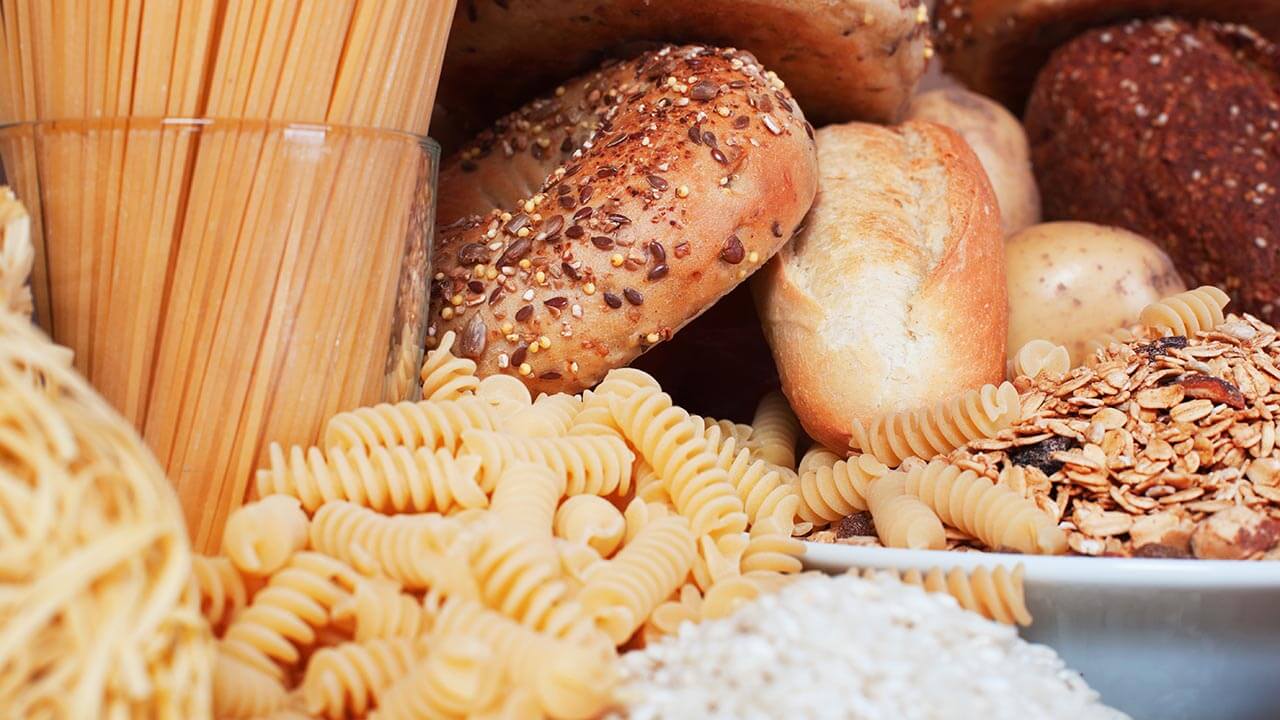

Carbohydrate loading is when you greatly increase the amount of carbohydrates you eat several days before a high-intensity endurance athletic event. You also typically scale back your activity level during carbohydrate loading. Is it for you? Are there benefits to carbo-loading? Should you be cautious about trying it? These are “loaded” questions, so let’s dig in a bit deeper.
Carbohydrate is an essential nutrient that your body needs for energy, and it is the preferred source during physical activity. Perhaps you have heard the popular terms of complex and simple carbohydrates; but what is the real difference between the two?
Complex carbohydrates are often called “starches” and consist of legumes (beans, peas, and lentils), breads, pastas, cereals, rice and vegetables like potatoes, corn and carrots. Complex carbohydrates have more dietary fiber than their simple counterparts, which consist of milk, fruits, yogurts and sugar-sweetened foods such as candy, jam, table sugar and baked goods. After eating, our bodies break down both of these types of carbohydrates into sugar called glucose. The cells in your body run on glucose because during digestion, glucose moves into the bloodstream, which carries it to your cells where it is used as a source of energy. Have you ever “bonked” or “hit the wall” during a long run or race? If you have felt very weak and tired and unable to go on, it may have been because you depleted your glycogen.
Glycogen is a form of glucose that is stored in your liver. Your body depends on it when the glucose has been used up. While most people store only small amounts of glycogen, endurance athletes need more given the fact that they often train or compete for more than 90 minutes at a time. Carbohydrate loading is a technique that may help ensure that your stamina is all that it can be. The goal is to take in enough extra (but not too much) carbohydrate to build up the body’s glycogen stores. Cutting back on your training at the same time helps to save the glycogen you are making.
There is a vast difference between a healthy balanced meal plan, which includes many carbohydrate-rich foods and a targeted-carbohydrate loading plan. Carbohydrate loading can be safe for most endurance athletes. However, like any training decision, it’s important to note that it also has some risks and side effects.
Ultimately the decision is yours. Will you carbohydrate load or not? If you want further information Runner’s World provides the following resources and will guide you with this decision.
Carbohydrate is an essential nutrient that your body needs for energy, and it is the preferred source during physical activity. Perhaps you have heard the popular terms of complex and simple carbohydrates; but what is the real difference between the two?
Complex carbohydrates are often called “starches” and consist of legumes (beans, peas, and lentils), breads, pastas, cereals, rice and vegetables like potatoes, corn and carrots. Complex carbohydrates have more dietary fiber than their simple counterparts, which consist of milk, fruits, yogurts and sugar-sweetened foods such as candy, jam, table sugar and baked goods. After eating, our bodies break down both of these types of carbohydrates into sugar called glucose. The cells in your body run on glucose because during digestion, glucose moves into the bloodstream, which carries it to your cells where it is used as a source of energy. Have you ever “bonked” or “hit the wall” during a long run or race? If you have felt very weak and tired and unable to go on, it may have been because you depleted your glycogen.
Glycogen is a form of glucose that is stored in your liver. Your body depends on it when the glucose has been used up. While most people store only small amounts of glycogen, endurance athletes need more given the fact that they often train or compete for more than 90 minutes at a time. Carbohydrate loading is a technique that may help ensure that your stamina is all that it can be. The goal is to take in enough extra (but not too much) carbohydrate to build up the body’s glycogen stores. Cutting back on your training at the same time helps to save the glycogen you are making.
There is a vast difference between a healthy balanced meal plan, which includes many carbohydrate-rich foods and a targeted-carbohydrate loading plan. Carbohydrate loading can be safe for most endurance athletes. However, like any training decision, it’s important to note that it also has some risks and side effects.
- If you have diabetes, please consult with your physician before beginning this carbohydrate loading regimen because it will greatly increase the amount of carbohydrate-rich foods you take in. This change can dramatically change your blood sugar levels.
- As your body stores glycogen, it also stores water as a result of the carbohydrate loading. This can cause weight gain and feelings of bulkiness that you may not appreciate days before an event. Most of the weight gain is water weight, but it is something you may want to consider before carbohydrate loading.
- Digestive complaints and bloating are common side effects of carbohydrate loading because many foods rich in carbohydrates are also rich in dietary fiber. If your body isn’t used to this increase in fiber, bloating, constipation or diarrhea can result. Fiber should be an important part of your diet (30-35 grams of fiber per day), but a few days before your event is certainly not the time to increase it.
- If your activity takes 90 minutes or less, carbohydrate loading isn’t really for you as it is primarily designed for those that compete longer than the 90-minute time frame.
Ultimately the decision is yours. Will you carbohydrate load or not? If you want further information Runner’s World provides the following resources and will guide you with this decision.



